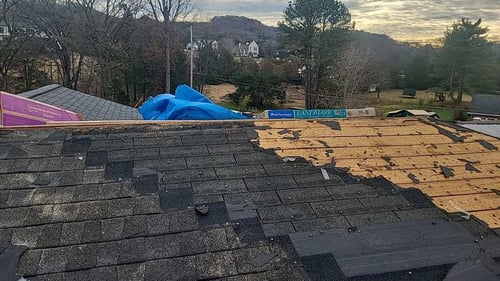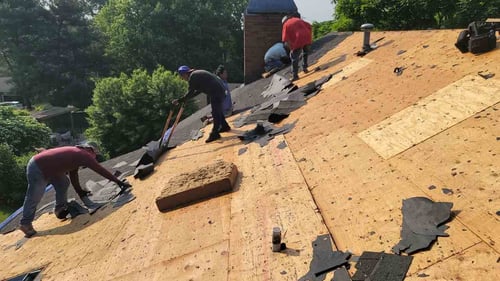Getting a new roof puts a big strain on your wallet. That’s why homeowners on a tight budget consider nailing over their current roof with new asphalt shingles.
But is this a good idea? Is a nail-over reroof better, worse, or the same as a roof replacement? The only way to answer these questions is to compare the two options.
For over 30 years, the team at Bill Ragan Roofing has provided homeowners with transparent and unbiased advice so they have the power to make the right decisions. That’s why I want to help you determine if a nail-over reroof or roof replacement is right for you.
This article answers the following questions:
- What is a nail-over reroof? (plus the pros and cons)
- What is a roof replacement? (plus the pros and cons)
- Is a nail-over reroof or a roof replacement right for you?
What is a nail-over reroof?
A nail-over reroof is nailing new asphalt shingles over an old asphalt roof. This type of reroofing skips the tear-off process, which means certain roofing components aren’t replaced.
 (Example of two layers of shingles)
(Example of two layers of shingles)
Just know that most states only allow two shingle layers on a roof for fire safety reasons. So, a reputable roofing contractor will recommend a roof replacement if your roof already has two or more layers.
What are the pros of a nail-over reroof?
Cheaper than a full roof replacement
The main pro of a nail-over reroof is that it’s simply cheaper than a roof replacement. Because it's skipped, you don’t have to pay for the labor and dump fees associated with the tear-off process.
You also won’t have to pay for certain materials because the entire roof isn’t being replaced. And because of all this, the labor costs as a whole also go down because it takes less time to complete a nail-over reroof.
However, the extra layers also increase these exact costs when replacing your roof in the future.
Shorter and easier installation
Speaking of less time, the next pro of a nail-over reroof is that it’s a shorter and easier installation. Not only does this bring the cost down, but it also means roofers are on your property, blocking your driveway and making noise for less time than a full roof replacement.
What are the cons of a nail-over reroof?
Must meet certain qualifications
To get a nail-over reroof, your current roof must meet certain qualifications. Your current asphalt roof must be near the end of its lifespan and lying down flat (no lifted or cracked shingles, blisters, or bumps).
The roof can also only have a few penetrations, a small amount of flashing, and no walls that butt up against the shingles. And remember, it can’t have more than one layer currently installed.
You don’t get to replace failing materials
The biggest con to a nail-over reroof is that you’re not replacing failing materials and components. Once roofing materials and components reach the end of their life, the only thing left to do is replace them because they are no longer fully functioning.
A nail-over reroof just puts new shingles over a failing roof, which only covers problems that won’t disappear until it’s fully replaced.
Repairs are harder to find and fix
Because a nail-over reroof is installed over a failing roof, future leaks are harder to track and repair. Water could get underneath the new shingles in one place and then leak into your home through a completely different area on your old roof.
This means both roofs will be repaired in different spots, which can get costly. There’s also no guarantee that the repair will fix the problem the first time because tracking the source is much harder.
Adds weight to your roof
Adding another layer of shingles on top of an existing asphalt roof adds more weight. This is fine under normal circumstances, but there isn’t a chance to replace any compromised roof decking because your old roof wasn’t torn off.
-1.jpg?width=500&height=391&name=DeckingRotten%20(2)-1.jpg)
If the roof decking is rotten or compromised, this extra weight can lead to structural damage and even a cave-in.
Short lifespan
A nail-over reroof will last as long as the shingles hold up. However, it’s unlikely for a nail-over reroof to last as long as a good quality fully replaced roof.
Doesn’t qualify for the best material warranties
The shingles nailed over an old asphalt roof come out of the package with a material warranty. Depending on the shingle, this will be anywhere from 25 to 30 years (the warranty prorates after a certain number of years).
However, a nail-over reroof doesn’t have a chance to qualify for the 50-year non-prorated enhanced warranty. This is because the roof wasn’t fully replaced using all the manufacturer's components and materials.
No resale value
A new roof increases your home’s value, which means you’ll recoup some of the cost when selling your home. However, a nail-over reroof won’t add much or anything to your home’s value.
This is because a multi-layered shingle roof shows up on the inspection report, and there’s really no selling point. All it tells potential buyers is there’s a failing roof under the top layer(s) of shingles.
Limited material options
When getting a nail-over reroof, your roofing material options are limited to 3-tab or architectural asphalt shingles. You’ll either have to use the same type of shingle or deal with an aesthetic issue if you upgrade from 3-tab to architectural.
While metal is also an option, I don’t recommend it.
What is a roof replacement?
A roof replacement is tearing off your old roofing materials down to the decking and installing all-new roofing components (underlayment, shingles, etc.). This type of reroofing ensures you get a brand-new roof from the top down.

However, you must hire a great roofer to ensure you get all the benefits of a new roof.
What are the pros of a roof replacement?
You’re getting a full new roof
The main pro when getting a full roof replacement is that you’re simply getting a new roof. All of your failing roofing materials and components are replaced with brand-new versions that will last 20 years or more.
This not only ensures you're replacing a failing roof before problems show up, but you’ll also get peace of mind for decades after installation.
Better material warranties
Unlike a nail-over reroof that doesn't qualify for an enhanced warranty, a full roof replacement does. Using the materials and components from one manufacturer qualifies a new roof for the 50-year non-prorated enhanced warranty (as long as the roof is properly installed).
This provides long-term protection on your roof investment, which gives you even more peace of mind.
Increases your home’s value
As I said, a new roof always increases your home’s value. For an asphalt shingle roof, you’re looking at around a 61% return on investment.
This means an asphalt roof that costs $29,000 increases your home’s value by more than $17,000 when putting it on the market.
More roofing material options
Because your old roof is torn off down to the decking during a roof replacement, the (roofing material) world is your oyster. This means you can choose any type of roof to fit your style, budget, lifespan, and more.
A roof is a huge piece of your home’s curb appeal, so it’s great not to be limited on material options.
What are the cons of a roof replacement?
A full roof replacement is expensive
The biggest con, concern, pain point, and every other issue when needing a new roof is the cost to replace it. A roof replacement is a big investment, with the average cost being around $15,000 for smaller or average homes.
I understand cost is a huge factor when making your decision, but you get what you put into a roof investment. Getting a cheap roof is the difference between peace of mind for 20 years and needing a new roof in 5 to 10 years due to premature roof failure.
Big home improvement project
The other con to a roof replacement is that it’s a big home improvement project. The entire process is chaos, but a reputable roofing contractor makes it controlled and smooth.
There will be a lot of noise, trash, and a big crew working on your property, and your driveway will have vehicles and a dump trailer until the project is completed. If you have a big home with multiple stories and a complex roof, it could even take multiple days, a week, or longer.
Is a nail-over reroof or a full roof replacement right for you?
Now that you know the pros and cons between a nail-over reroof and a roof replacement, you’re ready to decide which one is right for you. A nail-over reroof is cheaper, but you won’t get an enhanced warranty, your home value won’t increase, and you’re just putting a band-aid over a failing roof.
And remember, your roof has to be the right candidate for a nail-over reroof. On the other hand, a full roof replacement gives you a brand new roof with all new materials and components, which gives you everything a nail-over reroof doesn’t, but at a higher cost.
That’s why I always recommend a roof replacement to homeowners. And if you're worried about the cost, you have the option to finance your new roof.
What else should you consider before replacing your roof?
After reading this article, you should know if a nail-over reroof or a roof replacement is right for you. Keep in mind that you won’t know if nailing over your current roof is an option until after an inspection.
However, deciding which reroofing option is one thing you must consider when getting a new roof. So, before picking up the phone or looking for a roofing contractor, you need to learn the other roof replacement considerations.
Check out the 7 Things to Consider Before a Roof Replacement to ensure you make the best decisions and have the right knowledge before diving into the process.



